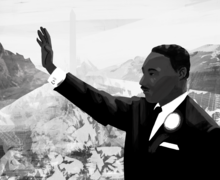Dalai Lama through the years: a look at important events for the 14th Dalai Lama
1935-1940
Lhamo Dhondup, now known as Tenzin Gyatso, was born July 6, 1935, in a small farming village in Northeastern Tibet. After four years of searching, the High Lamas found him at the age of two. He was then officially recognized as the reincarnation of the 13th Dalai Lama. In 1940, Tenzin Gyatso went on a three-month journey to Lhasa, where he was formally instated as the 14th Dalai Lama.
1950
The Republic of China declared a plan to invade Tibet, an independent state at the time. Tibet turned to the United Nations for support in a peaceful resolution. At a conference in Beijing, Tibetan representatives negotiated the “Seventeen-Point Agreement for the Peaceful Liberation of Tibet.” This treaty prevented China from attempting to change any religious, cultural or political institutions or traditions.
March 1959
At a pivotal time in Tibet’s history, the people demonstrated nationalism when they discovered China’s plan to capture the Dalai Lama. On March 10, 1959, Tibet launched a demonstration of 300,000 people at Norbulingka Palace to protect the Dalai Lama.
On March 19, the Chinese began to shell the area in hopes of deterring a full-out uprising. Over the course of a few days, the Chinese military had killed more than 86,000 Tibetans. The Dalai Lama fled to India two days earlier. Approximately 1.2 million Tibetans died due to the Chinese rule.
April 1959
The Dalai Lama’s highest priority after reaching India was reinstating the Tibetan government. In April, he established the Central Tibetan Administration (CTA) to represent the Tibetan people and to help the refugees recover and establish themselves as a sovereign, democratic nation. The organization is often referred to as “Tibet in exile.”
It still exists today with seven different departments focusing on religion and culture, home, finance, education, health, security, and information and international relations. The organization has bases around the world.
1964-1965
After years of fighting for an established government, the Tibet Autonomous Region officially merged into China to assert responsibility for Tibetan independence, promote freedom of religion and a society free from class division. During the Chinese Cultural Revolution, the Chinese destroyed thousands of Tibetan places of worship, museums and art. This happened after the United Nations General Assembly passed a resolution urging China to respect the Tibetan people’s basic human rights and self-determination.
1987
The Dalai Lama spoke in front of the United States Congress to establish support for his Five Point Peace Plan. The five points included China respecting the Tibetans’ political freedom and basic human rights, forbidding China from using Tibet to test nuclear weapons and dispose of nuclear waste, barring the population transfer policy, establishing Tibet as a demilitarized, peaceful area, and launching Tibet as an independent, democratic government.
1989
The Dalai Lama was honored with the Nobel Peace Prize on December 10, 1989, for his pacifist actions to defend Tibet from Chinese control. The way he handled and led 100,000 Tibetans in “government exile” seemed unlike any other event in history. The Norwegian Nobel Committee said he worked toward peaceful solutions in hopes that Tibetan heritage would be preserved, and the selection committee admired that he displayed leadership and responsibility toward all humanity and nature. The Dalai Lama was selected from 101 nominations, including Nelson Mandela and Ronald Reagan.
2011
The Dalai Lama stepped down from his political role in Tibet to permit a new generation of political leaders to take over. Although they elected a prime minister to lead Tibet in exile, the Tibetan people still want the Dalai Lama to make the major political decisions. He also stepped down to allow the democratic system to take off and provide a new hope for Tibet — they will now get to vote for their leaders, as promised years ago. The Dalai Lama remains a spiritual leader and hopes to keep the political life separate.
—Compiled by Marissa Blanchard, contributing writer, mjblanch@syr.edu
Published on October 8, 2012 at 4:58 am
Contact Marissa: mjblanch@syr.edu





